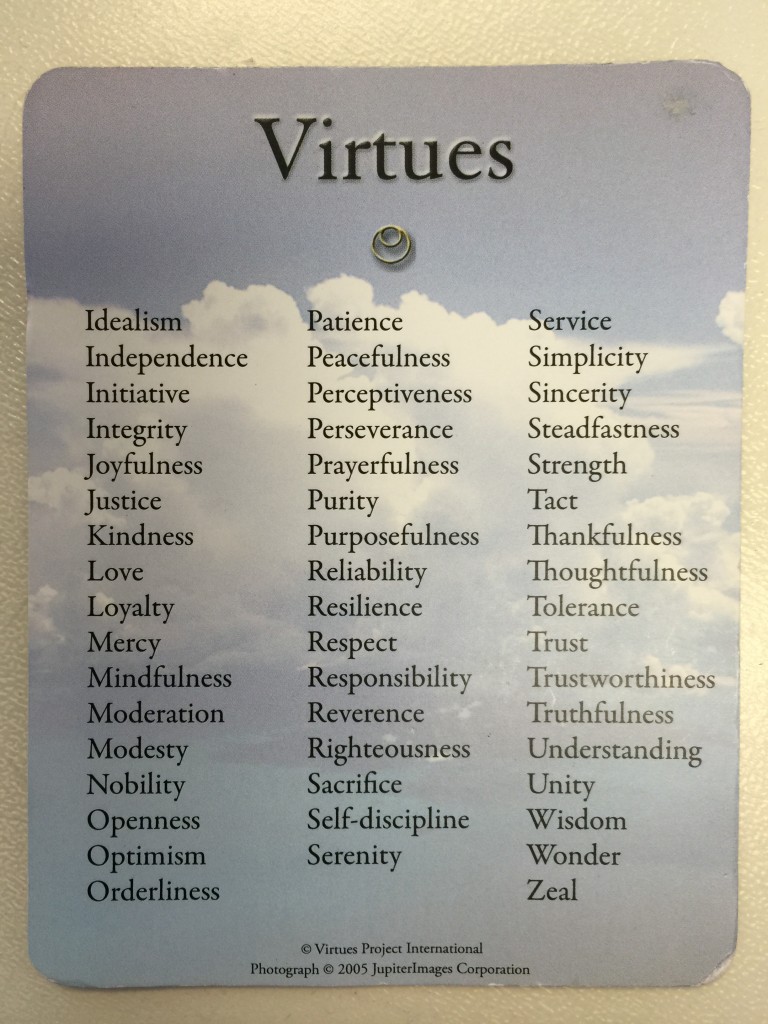#5 of the Five Strategies of The Virtues Project details click here
5. Offer Companioning
Being deeply present and listening with compassionate curiosity guides others to find clarity and to create their own solutions.
How well do you listen to others, to yourself? What really needs to be heard?
Core Values (Character) & Virtues–are they the same thing? Yes, in that they are woven into the same “fabric of character.”
As I recently took a course at the Anne Arundel Community College’s TEACH Institute and Parenting Center–Introduction to the Virtues Project–now, with a better understanding of what the Virtues Project is, and how it aligns with The JNP Project, I am beginning to reference all this as a term I like to call the “fabric of character.” Core values are which The JNP Project’s adventure book series, Jane & Jake’s Adventures to Awesome (and all supporting empowerment tools) focuses on: Truth, Kindness, Harmony, Forgiveness, Giving, Love, Determination, Compassion, Strength, and Character, and The Virtues Project complements all this SEL (Social Emotional Learning) beautifully.
The JNP Project focuses on core values, which together, make up our individual character. Our “Me!” In the White Paper, Virtue Ethics without Character Traits, by Gilbert Harman, Princeton University, 8/18/99, he states, “In one version of virtue ethics, moral virtues are robust character traits possessed by ideally morally virtuous people. The character traits in question are acquired robust habits of perception, motivation and action: habits of perceiving situations in certain ways, habits of being motivated to act in certain ways, and habits of actually acting in those ways. In this view, to specify a moral virtue is to specify the relevant perceptual, motivational, and behavioral habits.” Summing up to character.
In the Character Traits Chart, by Character-in-Action® (image below) notes that “virtue” is one of their listed character traits. Character-in-Action defines the virtue trait as: Virtue = begins by comprehending that there is a clear, absolute standard of right and wrong, and then acts to bring every area of life into conformity to that absolute standard. And, The Virtues Project’s mission is “recognizing the gifts within.”
In conclusion, I wanted to state that our character, the essence of who we believe we are, in which we draw our strengths and values from (our own inner-awesome super-powers), is in essence our fabric of character–made up of core values and virtues. That is why it is so important to me to take note of our virtues and be advised by our virtues facilitators as we continue to create content for JNP.
#5 of the Five Strategies of The Virtues Project details click here
5. Offer Companioning
Being deeply present and listening with compassionate curiosity guides others to find clarity and to create their own solutions.
How well do you listen to others, to yourself? What really needs to be heard?

NOTE: This series is written as a GUEST BLOG by our own JNP Advisory Committee Member, Ms. Biteena Frazier — now, our JNP Ambassador to the Middle East. She is a Master Solution-Focused Practitioner, PCI Certified Parent Coach and Virtues Project Facilitator. She has left the USA to pursue an interesting opportunity to help develop a behavior management and character development program for a new international school in the Middle East.
 OFFER COMPANIONING
OFFER COMPANIONING
When a child, friend or colleague comes to us with a problem, we have the opportunity to Offer Companioning. What this means, is that we don’t jump in with our suggestions and solutions. Instead, we listen respectfully assuming that the person has the wherewithal to solve his or her own problems. All too often, we feel the need to give advice to a friend or rescue a child from a problematic situation. We do this because we care but an even greater way to show caring is to be deeply present to someone, giving them space to think and feel without meeting our own need to “fix” things. When we Companion, we practice good listening skills and ask “cup emptying questions” so that the person feels validated and can discover their inner knowing in the process. This type of listening is similar to the “active listening” practiced by counselors. Giving advice is well meaning but it can have a dis-empowering effect and make children dependent on us. Companioning, on the other hand, is a way of listening that empowers others. Children who are companioned by parents and teachers, feel respected and able to address many problems on their own. This way of listening also builds trust and encourages children to come to us with their problems.
Numerous skills are involved in Offering Companioning and I would not necessarily recommend trying to do it all at once when you are just learning the steps. I would suggest starting with the parts that feel easiest and then adding the other bits and pieces as you go along. The last step is the most important, so that could be a good place to start. A companioning session always ends with a Virtues acknowledgment – a verbal recognition of the strength of character you have witnessed, whether it was determination, caring, resilience or idealism. When a person comes to you with a struggle, for sure they bring great strength to the problem and it is vitally important to recognize not just the struggle but what they do well or the positive intention behind the struggle.
The first step in Offering Companioning is staying silent and showing a willingness to simply listen (notice that listen is an anagram for silent). Follow silence with “cup emptying questions,” meaning questions that are open ended and express curiosity. Questions beginning with the word “what” are typically more effective than questions that begin with “why.” “Why” questions can create defensiveness and justification, but you want to encourage exploration in order to get to the “heart of the matter” (the thing that is most difficult). You never leave someone sitting at the bottom of their cup. After they have revealed what is most painful for them, you lift them back up by asking “Virtues reflection questions” such as, “What would give you the courage to …” to help them explore areas of growth. These are followed by “integration questions” such as, “What is clearer for you now?” giving them an opportunity to reflect on what has been most helpful in the conversation. Once they have thought about this, you close the Companioning session with a Virtues acknowledgment so they are left standing on a strong foot.
Learning to companion is not easy, particularly with one’s own children. Parental instinct to protect is strong and it is natural to want to save your child from pain. In order to Offer Companioning, a parent has to make a concerted effort to practice Detachment. To companion you need to lead with Compassion for your child and have utmost Trust in his or her personal journey and capacity to grow and learn through adversity.
A short version of the Companioning process is this: stay silent, stay curious (avoiding the word “why”), validate struggle and acknowledge strength.
For details of The Virtues Project go to their website at www.virtuesproject.com.
Below is the basic list of 100 virtues:

 * Ms. Biteena Frazier, is a School Counselor, and will be training staff in The Five Strategies® of The Virtues Project® at a school in the middle-east, with children from over 40 countries around the globe! She will be involved with The JNP Project as our Ambassador to the Middle-East, and will be Skyping with me regularly. As Biteena grows into her role, I will share more with you on the positive learning and experiences she is having overseas.
* Ms. Biteena Frazier, is a School Counselor, and will be training staff in The Five Strategies® of The Virtues Project® at a school in the middle-east, with children from over 40 countries around the globe! She will be involved with The JNP Project as our Ambassador to the Middle-East, and will be Skyping with me regularly. As Biteena grows into her role, I will share more with you on the positive learning and experiences she is having overseas.
Join Jane, Jake and all their friends on the adventures to discover your inner awesome, together!
~ ~ ~
Note: This Blog is a chronological diary of a start-up-company—The JNP Project’s Journey—reading it from the start, will broaden your understanding of the path we are on, together, and hopefully, positively influence you in some way!
FYI Tip: To get the overall understanding of Character Traits & Virtues, and the Language of Virtues, read all of the 8 blogs in this Founder’s Blog series.






Comments are closed.